I can remember my first experience with a mud crabs as if it were yesterday. I was minding my own business flicking lures for barramundi and mangrove jacks on the Lee Point Road at Buffalo Creek boat ramp, just out of Darwin.
A total stranger came up in a 12’ tinny and asked if I had a lighter, he had a few problems with a fuel hose. I give him a lighter and he proceeded to heat the end of his fuel hose to expand it enough to attach it to a fuel fitting.
I was backing away from him pretty quickly and thinking, ‘You’re one crazy dude, a lighter and fuel don’t mix, mate!
But I got talking to him and he said he’d dropped off a few crab traps up the creek and if I wanted I could go up and try for a barra at the next junction, where a couple of creeks met.
The lighter episode should have been enough for me not to go but I thought, ‘what the heck’ and I jumped in.
We started pulling in crab traps made from chicken wire, they were like baskets.
After about pulling up about 20, I asked how many he was legally allowed to have. Back in those days you could have 10 traps per person, so with me there it was legal to have 20, which we had already brought up. But he still had about 10 more in the creek, then a few just tied in the mangroves.
He pulled them up and when we were done. There were at least 35 traps and about 50 huge mud crabs all tied up in a hessian bag.
We stopped at the creek junction and threw a few lures about, then heard a motor of what we thought was another boat in the distance. As it came closer we saw it was a helicopter, a Fisheries helicopter!
It hovered over us and as I looked at this bloke through the pile of wire traps I was thinking, ‘I can lose my rods, tackle and even my car outta this’. I was in a bad situation.
My ‘mate’ gunned the 15 horses to full throttle and the small tinny rose up and headed into the smallest side creek with little room for a boat, as he started yelling ‘Get rid of the traps!’ but all I could do was sit there panicking about what was going to happen to me.
We dumped the traps and bashed over tree stumps and branches, chucking everything as well as ourselves all over the boat. He stopped the donk and we sat there for what felt like forever but was really about 10 minutes before we sneaked out of the creek and headed for the boat ramp.
I said, ‘Let me off at the mud bank up ahead, I’m going to walk back. I wanted nothing to do with this and don’t worry, I have seen nothing. I don’t want to be involved in any of this.’
As we headed to the bank the helicopter swooped over the embankment and we were told to stop. My mate didn’t listen and we took off for the boat ramp.
The chopper gave chase and I got out at the ramp while the crab thief kept going. I jumped in my car and headed towards Casuarina and about 5km along the road shot past Fisheries and National Parks vehicles racing the other way.
I don’t know what happened to the bloke but I was glad to just be far away from him.
These days my mud crab adventures are a lot more peaceful!
I have been chasing muddies for over 20 years now, mostly in the upper estuaries of Port Stephens and the Hunter River.
Nearly every estuary north of Sydney holds mud crabs in some sort of number but these days it can be hard to find them. They’re also encountered occasionally south to the Victorian border.
The three main types of gear for catching crabs: the fully enclosed traps, dilly or lift nets and the witch-hat nets.
A fully enclosed trap can be left out longer and once a crab is trapped it is unable to get back out again. If it’s a female crab you can bet some big males will not be far away.
Females attract big buck males and at times you can get many to enter the traps. Males are always larger than females.
I know in NSW you can legally keep females that aren’t ‘in berry’ carrying a large cluster of yellow eggs. Those carrying eggs have to be released by law.
I let all the females go, just so it sustains the population of the area you are fishing. The female is easily recognised by the belly flap, it has egg-retaining hair inside and is broad and square, where the male flap is tapered and slender with no hair.
Mud crabs have a lot of meat in them, especially from August through to Summer, and they should weigh a fair bit. At other times they haven’t got much meat in them.
These ‘empty’ crabs are easy to pick because they are very light and are only shell.
If you press under the belly softly you will be able to feel how soft the shell there is; a full crab is hard as a rock and pretty heavy. If you think it’s too light for its size throw the crab back.
The very best time to find mud crabs is after big rains. After rain they are flushed out of creeks and small channels and roam out in the dirty water, sometimes kilometres away from their homes in creeks.
As the salinity levels increase again, they will retreat back into the creeks and smaller channels again.
Mullet, especially fresh mullet, are the top bait for mud crabs but any fresh fish will do.
The main thing is to secure the bait well – muddies have strong claws and can rip up a bait very fast and can then exit a dilly or witch hat.
Some crabbers set traps in smaller channels of creeks that can dry out on the low tide and come back to check the traps at high tide when the water is deep enough for a boat. (It’s best not to do this because birds and animals can enter an exposed trap at low tide and then drown when the tide comes back in. In Queensland it’s illegal to set a trap so it dries out at low tide. – Ed.)
The spring tides around new and full moon bring bigger tidal variation and more run, allowing crabs to move around more easily. A higher tide can also allow us to enter areas that are usually too shallow at other times.
There are a lot of places you don’t even need a boat to catch mud crabs. Some guys can walk into a mangrove drain not far from a road on low tide, set their traps and come back on the next low water to check them.
Even little wharfs in mangrove or muddy areas can be handy places to drop a net, trap or dilly.
Mud crabs aren’t hard to catch and where there is one there are usually many.
When setting out to chase muddies, make sure all your equipment is legal for where you’re crabbing.
Don’t lay your gear out in a main channel where boats can tangle up with the lines.
I prefer dillies or lift nets and I check them every two hours because the crabs can wander off the dillies if you leave them too long.
Witch hats are great but usually one crab and they’re history. The tangles and hassles to me just aren’t worth it.
I carry replacement net, which is only a couple of dollars, and I replace the whole net.
Fully enclosed traps are more cumbersome, tough to lug around in a small boat and can be heavy. But I do better sometimes with this one trap than all the others put together, so if you’re allowed to set one, it’s worth considering.
Handling mud crabs is an art in itself and if you slip up, it can be painful. I have had very big mud crabs actually snap small diameter wooden dowelling.
If you can learn how to tie them up, this is the best way.
However, I just put them in large fish box with a wet towel over it. When I want to grab one, I grab it from the very back with the wet towel.
Never be at all casual with these guys, they’re quick and they’re cranky.
To prepare for eating, it’s humane to let them slowly chill out in an ice slurry for over 20 minutes.
Alternatively, chill them down until they’re dormant and then quickly insert and twist a screwdriver or similar between the eyes and upwards, all the way through to the rear end if possible, mushing up the front and rear nerve centres. Quickly grab the rear edge of the carapace where it joins the belly flap and rip it up and forward to remove it and then further pulp the nerve centres.
Crabs can be caught nearly all year round but September to March is the best season here and November and December are the best months.
So this Summer, consider putting out some gear for a muddy. If the fishing isn’t great you can still maybe take home a feed of yummy crabs.
Facts
NOT FOR EVERYONE
Mud crabs to most of us are delicacies but to one in about 100 people are so allergic to them their lips, mouths and hands become itchy and swollen and I have even heard of people dying.
Facts
LAWS VARY
In New South Wales the laws vary on how we capture crabs. Around much of the Hunter coast, an individual can possess one fully enclosed trap, five dilly/lift nets or five witch hats or hoop nets.
A little hint on transporting witch hats is to put an old towel or rags between each so they don’t tangle together.
Be careful: Crabbing regulations vary greatly from one area to another so you really need to make sure how many traps you can have.
Facts
SOME SET RULES
• Mud crabs must be at least 8.5cm from front to rear of the carapace. The bag limit is five per person.
• Enclosed trap floats must be not less than 100mm in all dimensions and at least 50mm must be above the water.
• All crab trap floats/buoys must be labelled ‘CT’ (crab trap) and hoop/witch hat nets with ‘HN’ plus the name and address of the person who sets, uses or lifts the gear. All lettering must be a minimum 15mm and in a colour contrasting with the buoy.
• All crab traps must have a 50g weight attached to the buoy at least 1m below the surface so no rope is floating on the surface.
• Hoop nets or lift nets must not have any rope floating on the surface.
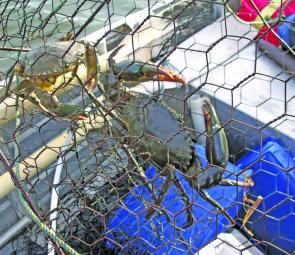
Two just legal mud crabs in a fully enclosed trap. These traps can be left out longer – overnight where legal.
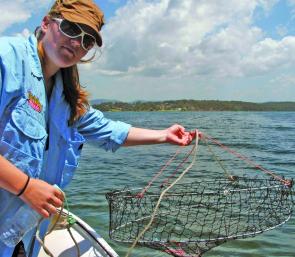
A dilly pot or hoop or lift net has to be checked regularly because crabs can come and go. A mullet bait is wired in at the centre.
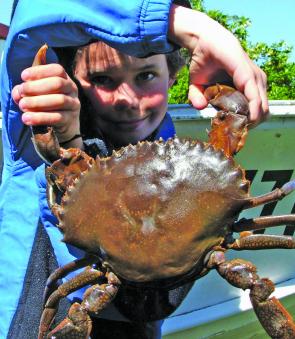
This huge mud crab came from a dilly pot set out at night on a full moon with a very large tide – the best time to hunt muddies.
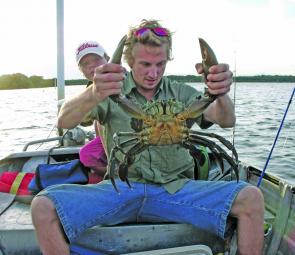
Talk about grabbing the bull by the horns… Mud crabs are faster and angrier than blue swimmers and their claws are incredibly strong – avoid them!
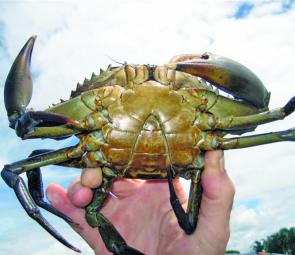
A safe way to hold a frisky muddy – by the bases of the swimmerets, with a steadying index finger well back on the carapace. Those claws can reach back a fair way but not to here. (a Wayne Lodington image)

A channel like this can hold numbers of mud crabs and you don’t need a boat to lay out a trap and check it every low tide.




